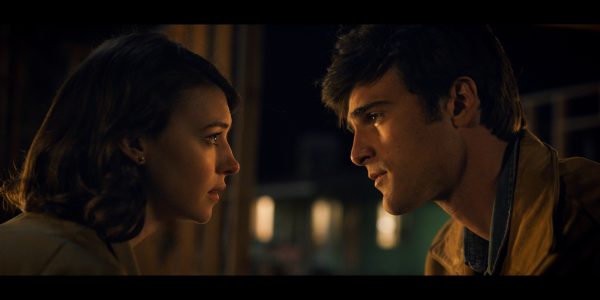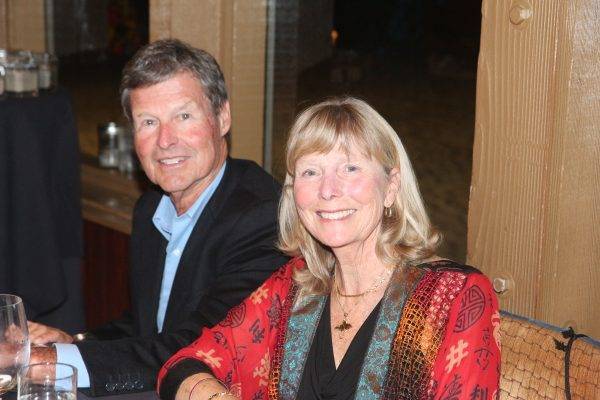
Loosely based on letters from Vincent van Gogh to his brother Theo and billed as a reflection on the last day of his life, Michael Gordon’s portrait of the Dutch painter plays up the torment and the sordidness rather than playing up the vibrancy. Staged by Long Beach Opera and presented recently at the BixbyKnollsExpoArtCenter, soprano Ashley Knight, tenor John Matthew Myers, and bass Jason Switzer moved slowly as if hypnotized while actor Mark Bringelson in the upper left quadrant of the set tossed and turned in feverish dreams.
Gordon’s score is far from drowsy or resigned, and the music (Gordon co-founded the avant-garde Bang on a Can) is often raw, gritty, rebellious, tribal, chockfull of repetition, and yet at times soothing and tender. A mournfulness emerged when Switzer (presumably as van Gogh) lamented that he’d like to live with a woman – and this was lachrymosely repeated with slight variations. The painter’s profound loneliness and desire for human warmth was pervasive and he sought temporary relief with Knight’s character who complied, reluctantly, accommodating herself to his sexual needs; love performed with intense melancholy and regret that leaves one even more forlorn than before and seems to mirror a very similar encounter – a mixture of Cranach, Munch, and Kafka – that Osman Lins evoked in Avalovara, surely one of the great Brazilian novels of our time (as translated by Gregory Rabassa):
“I go out into the night, I walk through the city and I see it emptying out. Lying down, I, with a whore; I embrace her as if I were embracing a being made of wire and hair of the dead. I ejaculate my hate, my testicles sob, I weep through my penis, I hear it moan. I still haven’t dressed and already the woman of whom I only saw the purse or shoes is leaving. She goes downstairs. I remain in the room, a room with naked walls, with nothing that can be stolen.”
That captures the desolate tone of “Van Gogh” rather than the painter’s later canvases that go wild with color and the spirals of ideas in motion. Here, the lighting was dim and much of the action, such as it was, involved the slow buttoning and unbuttoning of clothes.
“Wheatfield with Crows” was this production’s defining image, and at the end, as the singers stepped down, wheat fields were all that remained (even though crows or ravens are the true harbingers of death). Myers and Switzer – the former with his cherub-like voice, the latter resonant like a bronze gong – walked along the outer perimeters of the venue, still singing, and then Knight slowly proceeded up the center aisle. She has a rich, sonorous voice and a reviewer that evening might well have touched her arm as she passed to say, “Stay there; keep singing. I’m selfish; don’t sing for anyone else.”
“Van Gogh” is a moody piece with a sketchy libretto and a narrative that vanishes before it begins. Gordon premiered it in 1991 and re-orchestrated it in 2003. Benjamin Makino conducted the What’s Next? Ensemble, Adam Flemming was the video designer, and the stage direction and production design was by Andreas Mitisek.

Stewart Copeland – drummer and co-founder of The Police – was taken by Edgar Allan Poe’s short story, “The Tell-Tale Heart,” and his operatic venture (at just over half an hour) complemented Michael Gordon’s “Van Gogh.” Long Beach Opera updated Poe’s vignette about a man’s obsession with a neighbor’s hawk-like eye, a neighbor whom he eventually kills and buries beneath the floorboards.
There was some extraneous staginess in this production that seemed irreverent but it did set the table in a provocative and initially unsettling manner, dropping the audience into the seediest tenement in L.A. among hookers (Ashley Knight, Danielle Bond) and drug addicts. Bringelson, meanwhile, sat glued to a TV: If he resembled Henry Miller in “Van Gogh,” here he looked more like Hunter S. Thompson. At any rate, whether this carnivalesque pantomime was Copeland’s idea or Mitisek’s, it certainly pressed down hard on the gas pedal as it sped into madness and obsession.
As Edgar, Robin Buck must have been hired for his facial contortions as much as for his singing voice – both of which were superb. Pushed onto the stage in a wheelchair, he sang masterfully but didn’t do much true singing again until the end.
As with “Van Gogh” the set contained four quadrants, with Buck staying put in the lower right, ranting about insanity, and with such passion and vigor that one would have thought Shakespeare was the actual model for this composition.
Not surprisingly, the music is percussive-oriented, with potent irregularities, and extremely effective. However, it was the video projection (Adam Flemming again) that nearly stole the show. The viewer’s attention was drawn to each of the four screens, for the most part showing close-ups of Buck’s contorting face with his mock declamatory lines, as well as the other singers, briefly highlighted at intervals. To be honest, it was (like being in a funhouse) a bit much to absorb all at once.
There’s a murder, and perhaps several. It’s just not an easy piece to decipher because this is largely a psychological profile and what we saw manifested might simply have been what the wheelchair-bound Edgar envisioned doing. Even the policemen (Myers, Switzer) who showed up to investigate the murder of the neighbor (Bringelson) ended up as cadavers along with the aforementioned Knight and Bond as girls in the wrong place and the wrong time. In life and “in death,” both women sang very well.
“Tell-Tale Heart” is an invigorating work although in this case with subtlety mostly tossed along the wayside. Heavy-handed and heavy on the mayhem? Probably so. That said, it was a descent into the maelstrom worth taking.
Long Beach Opera returns with Macbeth (1906), by Ernest Bloch, presented at 8 p.m. on Saturday, June 15; Saturday, June 22; and Sunday, June 23, taking place at Berth 92, the World Cruise Center, in the Port of Los Angeles, San Pedro. (562) 432-5934 or go to LongBeachOpera.org. ER










